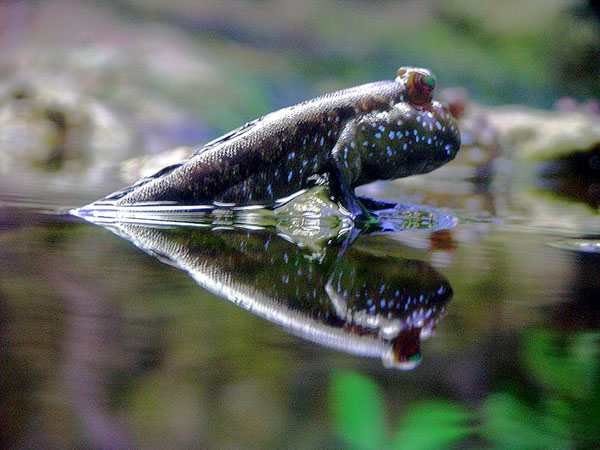
Posted on 09/14/2009 9:11:38 AM PDT by BGHater
Snakes are relatively recent so I would suspect the leg is a throwback rather than a step forward.
I wonder which one decides which way to go...
Snakes eat rats, let’s not forget.
Ha!

The fossil record does not indicate migration onto land via a process of ever-growing leg-buds. Rather, it demonstrates that the ancestors of all land vertebrates were lobe-finned fish, such as the modern-day coelacanth. Legs evolved not from leg-stubs but from fins.
Fish have fins. Fins are generally frail, delicate things, great for pushing water around but not well-suited for structural support.
Of course, some fish's fins are thicker and more solid than others. In the open water, thicker fins would put a fish at slight disadvantage due to reduced maneuverability and increased calorie requirements. However, in very shallow waters, thick, load-bearing fins would be very useful, because they allow a fish to maneuver through mud and even hop from one shallow pool to another over very short distances. Fish that grow thicker fins would therefore have a survival and reproduction advantage in shallow environments, where they can get food and escape predators with relative impunity.
Long story short, there was definitely a survival pressure for some species of fish to grow their fins into thicker, more load-bearing structures to take progressively greater advantage of the land environment, which was otherwise unoccupied by any other vertebrates at the time (but filled with tasty tasty plants and some insects). The process by which they did this doesn't have to require any kind of intent on the part of the fish itself nor of any other thinking being.
This relates strictly to vertebrates, of course. I'm unfamiliar with the evolution of arthropods, whose leg structures are completely unrelated. But a few minutes on Wikipedia will help you out.
That is, assuming, you actually want to know. If you're just playing a game of gotchya, please don't waste my time. But like I said, I'm assuming you're asking in good faith.
Thanks for the info!
*smack smack*!!!
Probably not, actually.
There's probably no disadvantage in having such tiny little leg-buds. That is, within the variance in size of existing leg-buds, there's no corresponding variance in survival. There's no reason to assume that snakes with smaller leg-buds have any reproductive advantage over snakes with larger leg-buds.
Those buds might eventually go away as the genes that encode for the formation of those buds change into meaningless, unusable DNA sequences through random mutation. However, such mutations would have to occur throughout the entire snake population on Earth in order to fully lose those buds forever (to be fair, such mutations don't have to occur at the same time nor at the same location in the DNA sequence; the point is just to mess up the DNA's ability to code for whatever protein forms those buds). When or if that happens, the broken codon that once coded for the buds will continue to exist in the DNA of the snake species, just one more of the hundreds of thousands of useless DNA sequences that every species carries around to hearken back to our evolutionary history.
I wasn’t kidding. I saw my first fish walk across the road while taking a canoe trip near Orlando. It was freaky.
Incidentally, it's worth mentioning that the advantage of fleshy fins in shallow or muddy waters isn't just some hypothetical article of faith. There are many species of fish today that climb on coral or dig through mud, and their fins tend to be fleshy and muscular. Take a look at the Frogfish or the more common Catfish.
There's no longer as strong a pressure for modern-day lobe-finned (or just thick-finned) fish to venture further and further onto land, as there was in the Devonian period. Back in the Devonian, there was nothing else on land other than plants and insects, so whichever fish that could climb the furthest out had a huge advantage over its peers; it could escape predators or mating rivals more effectively, and it had access to food that no other fish could reach. These factors would greatly increase the most far-climbing fish's rates of survival and reproduction, which it would pass on to its offspring. This, of course, was back in the Devonian. Nowadays, land is teeming with the distant ancestors of those Devonian fish pioneers, and we've adapted very, very well to our dry environment. As such, fleshy fish that venture far out of the water today might have access to food sources that their peers don't, but they're also likely to become lunch for an existing land animal that's better at the whole dry-land living thing than the floppy late-comer.
You missed my point.........
No worries.........
I have a warped sense of humor..............
That thing looks Romulan... Had any strange lights in the sky lately? ;-)

Cute little bugger, ain't 'e? :)
Nowadays he's just a squirmy little oddity. But back in the day, he (or a fish very similar to him) was the only vertebrate capable of getting onto dry (well, damp) land, which meant all the moss and insects of the Earth were his for the taking!
Those were the glory days, back in the Devonian period. Nowadays if he tries to go too far from his muddy home, he becomes bird food. But of course, birds are descendants of fish just like him 400 million years ago, so in a way he's a victim of his own success.
LOL, my apologies to snakes.
Good one.
LOL....true !
Disclaimer: Opinions posted on Free Republic are those of the individual posters and do not necessarily represent the opinion of Free Republic or its management. All materials posted herein are protected by copyright law and the exemption for fair use of copyrighted works.